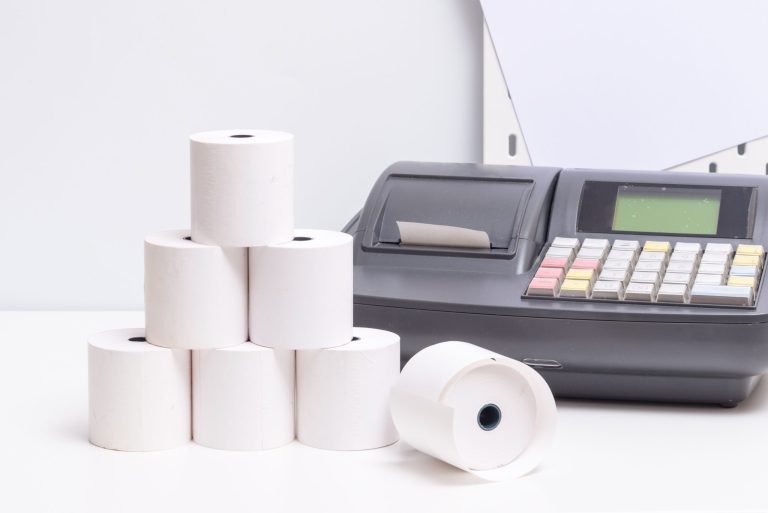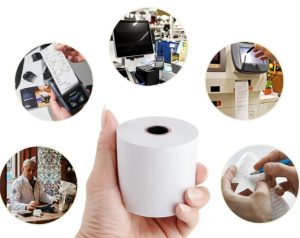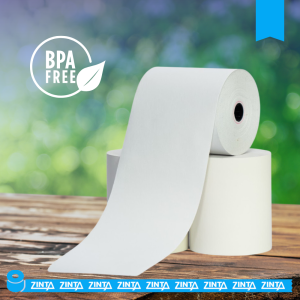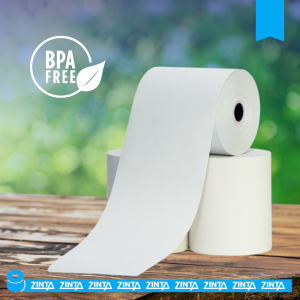In an era of accelerated digitalization, fast and efficient printing solutions remain essential in the daily operations of many industries. Although often overlooked in everyday life, thermal paper plays a key role in numerous critical processes — from issuing receipts to labeling products or parcels. Its popularity stems from the speed and efficiency of thermal printing technology, widely adopted across industries. However, behind these practical benefits lie increasing concerns about the chemical compounds used in its production, particularly Bisphenol A (BPA) — a substance at the center of public health debates and recent European regulations.
This article provides an in-depth look at the technical advantages of thermal paper and explains why compliance with BPA-free material standards is essential.

Thermal paper performance, benefits, and efficiency
Thermal printing technology offers several clear advantages:
- Speed: Thermal printers operate at impressive speeds, between 60 and 300 mm/s, unaffected by paper width. This accelerates transaction and documentation processes.
- Low noise: Unlike dot matrix printers, thermal printers operate quietly.
- Low energy consumption: Thermal printing technology optimizes energy use, significantly reducing operational costs and enhancing equipment efficiency.
- Low maintenance costs: Thermal printers have a long lifespan and require minimal maintenance.
- No additional consumables: No ink or toner required. Printing occurs through thermal activation of a special coating on the paper.
- Printing flexibility: Capable of printing any characters or images.
- Customization: Thermal paper can be pre-printed (branded or customized) before actual use.
Applications and use uases for thermal paper
Thanks to these advantages, thermal paper is used in a wide range of applications. It is found in fax rolls, self-adhesive barcode labels, airport baggage labeling systems, various types of tickets (entry, travel, event, lottery, parking), bank receipts, and most commonly, in POS printers for fiscal receipts.
It plays a key role in many sectors including retail, HoReCa, service industries (such as wellness centers), banking, courier services, and taxi operations.

Storage is key to print durability
To ensure printed information lasts over time, proper storage of thermal paper is crucial. It should be stored in cool, dry places, away from direct light and moisture. High humidity (over 60%) or high temperatures (over 40°C) can lead to rapid fading or complete loss of printed information. Avoid contact with substances such as organic solvents, detergents, alcohol, adhesives, acids, or oils. Z-journal rolls, for example, should be stored in cardboard boxes in well-ventilated areas, away from heat and moisture.
Thermal printing over time: how long does it last?
The durability of printed information depends on storage conditions and the quality of the printer’s thermal heads. When properly stored, records can last up to 5 years.
Legal obligations: BPA-free thermal paper
A defining and legally binding requirement for thermal paper usage, especially post-2020, concerns the presence of harmful chemicals such as Bisphenol A (BPA).
Bisphenol A (BPA) is a chemical compound used, among other things, in the production of polycarbonates. It is a type of phenol. Scientifically, BPA is considered extremely harmful to health, being linked to cancer, leukemia, asthma, and other serious conditions. Even Science Magazine in France highlighted the risks, stating that BPA is “more dangerous than previously thought.”
Due to these scientifically proven risks, European legislation has intervened. According to EU Regulation 2016/2235, issued by the European Commission, the sale of thermal paper containing BPA in concentrations above 0.02% has been banned since January 2, 2020. This legal measure directly targets industries that use thermal paper extensively, including retail, HoReCa, services (such as wellness centers), banking, and courier/taxi sectors.
As a result, businesses in these industries are legally required to use thermal paper with BPA content of 0.02% or less — in other words, BPA-free or near-zero BPA thermal paper. This means companies must not use thermal paper that exceeds this legally imposed threshold.
Responsible suppliers, such as IT Genetics, anticipated these changes and introduced BPA-free thermal paper rolls into their product range as early as September 2019, ensuring stock compliance with EU legislation before the 2020 deadline. The message to clients was clear: switching to BPA-free paper is essential not only to comply with regulations but, more importantly, to protect employee and customer health. Simply handling a BPA-laden receipt could expose individuals to harmful effects — imagine the impact on employees handling dozens or hundreds of such receipts daily.
The greatest benefit of switching to BPA-free thermal paper is, therefore, the direct health benefit for all users — whether employees or customers.

Modern thermal paper, compliant with current regulations, remains a fast and efficient printing solution, indispensable across a variety of commercial and service-based activities. However, the legally mandated transition to BPA-free variants adds a vital dimension: safety and health protection. Following proper storage protocols and choosing thermal paper that complies with European BPA legislation are essential steps for any responsible and efficient business.



